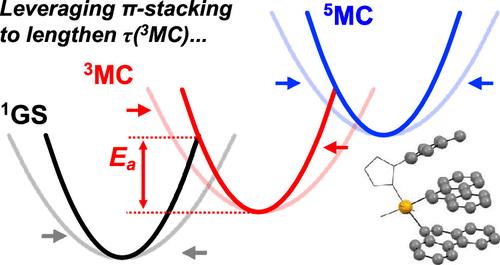Leveraging Intramolecular π-Stacking to Access an Exceptionally Long-Lived 3MC Excited State in an Fe(II) Carbene Complex
IF 15.6
1区 化学
Q1 CHEMISTRY, MULTIDISCIPLINARY
引用次数: 0
Abstract
The ability to manipulate excited-state decay cascades using molecular structure is essential to the application of abundant-metal photosensitizers and chromophores. Ligand design has yielded some spectacular results elongating charge-transfer excited state lifetimes of Fe(II) coordination complexes, but triplet metal-centered (3MC) excited states─recently demonstrated to be critical to the photoactivity of isoelectronic Co(III) polypyridyls─have to date remained elusive, with temporally isolable examples limited to the picosecond regime. With this report, we show how strong-field donors and intramolecular π-stacking can conspire to stabilize a long-lived 3MC excited state for a remarkable 4.1 ± 0.3 ns in fluid solution at ambient temperature. Analysis of variable-temperature time-resolved absorption data using theoretical models ranging from Arrhenius to semiclassical Marcus theory, combined with computational modeling and X-ray crystallography, reveal a Jahn–Teller stabilized excited state with a high activation barrier for ground-state recovery. The net result is a chromophore with a 3MC excited-state lifetime that is orders of magnitude longer than anything yet observed for an Fe(II) complex.

利用分子内π堆叠获得Fe(II)卡宾配合物的超长3MC激发态
利用分子结构操纵激发态衰减级联的能力对于丰度金属光敏剂和发色团的应用至关重要。配体设计已经产生了一些惊人的结果,延长了Fe(II)配位配合物的电荷转移激发态寿命,但金属中心三重态(3MC)激发态──最近被证明对等电子Co(III)多吡啶基的光活性至关重要──迄今为止仍然难以捉摸,暂时可分离的例子仅限于皮秒范围。通过本报告,我们展示了强场供体和分子内π堆积如何共同作用,在室温下稳定了一个长寿命的3MC激发态,持续时间为4.1±0.3 ns。利用Arrhenius理论和半经典Marcus理论对变温时分辨吸收数据进行分析,结合计算建模和x射线晶体学,揭示了具有高激活势垒的jan - teller稳定激发态。最终结果是一个具有3MC激发态寿命的发色团,这比迄今为止观察到的任何Fe(II)配合物都要长几个数量级。
本文章由计算机程序翻译,如有差异,请以英文原文为准。
求助全文
约1分钟内获得全文
求助全文
来源期刊
CiteScore
24.40
自引率
6.00%
发文量
2398
审稿时长
1.6 months
期刊介绍:
The flagship journal of the American Chemical Society, known as the Journal of the American Chemical Society (JACS), has been a prestigious publication since its establishment in 1879. It holds a preeminent position in the field of chemistry and related interdisciplinary sciences. JACS is committed to disseminating cutting-edge research papers, covering a wide range of topics, and encompasses approximately 19,000 pages of Articles, Communications, and Perspectives annually. With a weekly publication frequency, JACS plays a vital role in advancing the field of chemistry by providing essential research.

 求助内容:
求助内容: 应助结果提醒方式:
应助结果提醒方式:


